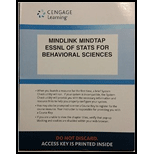
Concept explainers
a.
To Find: If the proportion of participants who claim to remember broken glass differ significantly from group to group for the given question.
a.
Answer to Problem 15P
Reject null hypothesis and conclude that proportion of participants who claim to remember broken glass differ significantly from group to group.
Explanation of Solution
Given info:
A sample of 150 students were involved in a study based on “the response they gave regarding the broken glass or verb used for speed”. The distribution is given in the question. Use
| Yes | No | Total | |
| Smashed into | 16 | 34 | 50 |
| Hit | 7 | 43 | 50 |
| Control (not asked) | 6 | 44 | 50 |
| Total | 29 | 121 | 150 |
Calculation:
Step 1: Null Hypothesis and Alternate Hypothesis are:
Step 2: For the given sample, degrees of freedom equals:
With
Step 3:
The formula to calculate expected frequency is:
Substitute
For the category “smashed into”, the expected frequencies are:
For the category “Hit”, the expected frequencies are:
Similarly, for the category “control”, the expected frequencies are:
The contingency table is :
| Yes | No | Total | |
| Smashed into | 16 (9.66) | 34 (40.33) | 50 |
| Hit | 7 (9.66) | 43 (40.33) | 50 |
| Control (not asked) | 6 (9.66) | 44 (40.33) | 50 |
| Total | 29 | 121 | 150 |
Here the values within the braces are the expected frequencies.
Finally substitute the values in the
Step 4: Rejection rule: Reject when
Step 5: Based on the results of hypothesis test, there is sufficient evidence to reject the null hypothesis at
Hence, reject null hypothesis and conclude that proportion of participants who claim to remember broken glass differ significantly from group to group.
b.
To Find: The value of Cramer’s V for the given question.
b.
Answer to Problem 15P
The value of Cramer’s V is 0.227.
Explanation of Solution
Calculations:
The formula for Cramer’s V is:
Here,
Substitute 7.77 for
Hence, the value of Cramer’s V is 0.227.
c.
To Describe: How does the phrasing of the question influenced the participants memories.
c.
Answer to Problem 15P
The phrasing of question influenced the participants memories little bit.
Explanation of Solution
Cramer’s V is used as post-test to determine strengths of association once the chi-square has determined significance.
A value of 0.227 indicates a small effect. That is, a little association between the groups.
d.
How would the outcome of hypothesis and Cramer’s V will be written in the report.
d.
Answer to Problem 15P
Report will be
Explanation of Solution
The result showed that the proportion of participants who claim to remember broken glass differ significantly from group to group.
Want to see more full solutions like this?
Chapter 15 Solutions
Essen.Of Stat. for Behavioral Sci. - Access
- Which model—the one for parliaments or the one for ministries (or cabinets)—presented in the article has the greater explanatory power? How can you tell?arrow_forwardIn general, ___________% of the values in a data set lie at or below the 28 th percentile. _______________ % of the values in a data set lie at or above the 90 th percentile.. If a sample consists of 700 test scores, _________of them would be at or below the 52 th percentile. If a sample consists of 700 test scores, ________ of them would be at or above the 64 th percentile.arrow_forwardThe table below shows the number of state-registered automatic weapons and the murder rate for several Northwestern states. xx 11.5 8.2 6.9 3.3 2.8 2.2 2.6 0.6 yy 13.7 10.9 10.2 7 6.1 5.8 6.3 4.2 xx = thousands of automatic weaponsyy = murders per 100,000 residentsThis data can be modeled by the equation y=0.87x+3.9.y=0.87x+3.9. Use this equation to answer the following;A) How many murders per 100,000 residents can be expected in a state with 2.5 thousand automatic weapons?Answer = Round to 3 decimal places.B) How many murders per 100,000 residents can be expected in a state with 5.2 thousand automatic weapons?Answer = Round to 3 decimal places. Submit QuestionQuestion 17arrow_forward
- The problem is on the first image attached, and the second image is the data to go with it.arrow_forwardThe table below shows the number of state-registered automatic weapons and the murder rate for several Northwestern states. xx 11.7 8 6.8 3.7 2.9 2.4 2.4 0.4 yy 14.3 10.5 9.8 7.2 6.6 5.8 5.9 4.6 xx = thousands of automatic weaponsyy = murders per 100,000 residentsThis data can be modeled by the equation y=0.86x+3.97.y=0.86x+3.97. Use this equation to answer the following;A) How many murders per 100,000 residents can be expected in a state with 3.4 thousand automatic weapons?Answer = __?__ Round to 3 decimal places.B) How many murders per 100,000 residents can be expected in a state with 9.4 thousand automatic weapons?arrow_forwardFor these data: No caffeine 200 Mg caffeine 400mg caffeine overall No Alcohol M=620 M=600 M=590 M=603 Alcohol M=720 M=700 M=690 M=703 overall M=670 M=650 M=640 A) Is there a main effect for alcohol? B)Is there an interaction? C)Does caffeine improve response time (produce faster times) for people who have consumed alcohol? D)Does caffeine eliminate the effect of alcohol on response time?arrow_forward
